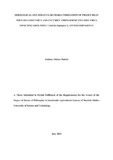| dc.description.abstract | Groundnut or Peanut (Arachis hypogaea L.) is an important oilseed legume crop in Kenya, but yields are declining due to pests and diseases. Plant viruses cause serious disease of crop plants reducing both quality and quantity of the final produce. New viruses previously not known to infect groundnuts, are being detected in groundnuts in the advent of Next Generation Sequencing (NGS) technologies. Phasey bean mild yellows virus (PBMYV, genus: Polerovirus; family: Luteoviridae) and Cucurbit aphid-borne yellows virus (CABYV, genus Polerovirus, family Luteoviridae) causes Phasey bean mild yellows disease (PBMYD) and Cucurbit aphid-borne yellows disease (CABYD) in cultivated crops and wild hosts respectively. PBMYV and CABYV poleroviruses were detected through NGS in groundnut samples from Kenya. The discovery of these new viruses with interveinal leaf necrosis, chlorosis, mottling, curling, deformation and puckering symptoms, highlights the underestimated diversity within the genus, which could be related to virus-like diseases with yet unidentified causal agents or the emergence of new diseases in cultivated crops. The viruses are new in Kenya and on groundnuts as a host. The serological and molecular characteristics of PBMYV and CABYV detected were not well known in Kenya. This would hinder their precise diagnosis and management in Kenya and on the new host. This study determined the occurrence, distribution, biological, serological and molecular characterization of PBMYV and CABYV detected in Kenya. Two disease diagnostic surveys were conducted during the short and long rain seasons of 2020 and 2021 in Bungoma, Busia, Kakamega and Siaya Counties of western Kenya. Socio-economic data of the groundnut farmers was captured in a questionnaire. A total of 345 farms were surveyed (245 in long rains and 100 during short rains). A total of 673 leaf samples were collected. Biological characterization of CABYV was done through mechanical and vector inoculation on popularly grown groundnut varieties, leguminous and solanaceous hosts. Disease incidence and severity was scored on the disease diagnostic score sheet. The survey data collected was subjected to analysis of variance using R Statistical Software Package version 3.6 and IBM SPSS version 28.0. Pairwise comparison of means was done using Least Significance Difference (LSD) at P ≤ 0.05 confidence level. Serological bioassays for CABYV were done with TAS-ELISA and RT-PCR for PBMYV. Total RNA was extracted from the leaf samples using RNeasy Mini Kit (Qiagen) and CTAB method, then used for double stranded cDNA synthesis using the SuperScript II kit. The samples were pooled then processed with the transposon-based chemistry library preparation kit (Nextera XT, Illumina). The DNA libraries were sequenced (200-bp paired-end sequencing) on the Illumina MiSeq benchtop sequencer platform (Illumina, USA). The reads were used for de novo assembly and contigs aligned to the viral genomes database using CLC Genomics Workbench 10.1.2. The assembled contigs were subjected to a BLASTn search against the GenBank database. Phylogenetic analyses and comparisons were performed using the MEGA X software. The short rains season recorded higher incidence (73.61%) than the long rains season (42.65%). PBMYV alongside CABYV were detected. The novel PBMYV full genome sequences from Kenya (PBMYV_6, PBMYV_7) clustered together implying common ancestry and a possible identity by descent (IBD) with other PBMYV sequences, and had closest sequence identity (91-95%) with PBMYV (KT963000.2, MT966033.1 and MT966038.1) in distinct clades. CABYV6-2 showed 94.5% nucleotide identity with CpPV2 isolate KX599164.1 from Burkina Faso and 83.4% identity with CABYV isolate MG257902.1 from Korea. This study documents the first reports of PBMYV and CABYV poleroviruses in Kenya with a new host record, A. hypogaea. This research findings are strategic in the development of sustainable management technologies of the two poleroviruses through multi-pathogenic robust diagnostics, breeding resistant groundnut cultivars and distinct understanding of vector-virus-host pathosystems interactions.” | en_US |

